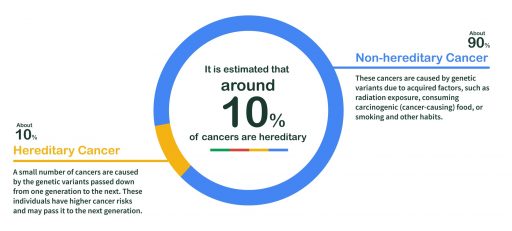What is hereditary cancer?
Cancer is the top killer in Hong Kong. According to the “Hong Kong Cancer Strategy 2019” report, cancer claimed over 14,000 lives in 2018. Many families have more than one member who has cancer – it is often the same type of cancer. This may be due to shared living conditions or lifestyles. For example, smoking or a high-fat diet increases the risk of cancer, and people sharing these aspects of their lifestyle may be similarly affected. In some cases, however, when the same type of cancer appears in multiple generations, it may be caused by genetic variants.
Hereditary cancer is often associated with the following types of cases:
- Confirmed cancer cases in relatives over more than one generation in the family; or
- The cancer is developed at an age younger than expected for that type of cancer; or
- The cancer patient is a child; or
- The same person has more than one type of cancer.

Does hereditary cancer affect children?
Yes. For most people, certain hereditary cancers, such as breast and ovarian cancer, do not develop until adulthood. Some physical symptoms of hereditary cancer, however, have much earlier onsets, such as Familial Adenomatous Polyposis (FAP), a rare genetic condition that occurs between childhood and adolescence.
If a disease-causing genetic variant is identified, cancer screening can be done at a younger age for better disease management.
Significance of Whole Genome Sequencing
Case Study (1) – Identify the Cause of Disease to Provide More Precise Treatment for Patients
In a medical check-up, a large number of polyps were found in Patient A’s large intestine. The clinician suspected that it was “polyposis syndrome” caused by a specific genetic variant.
For patients suffering from this condition, their large intestines would be filled with thousands of cancer-inducing adenoid tumours. To reduce the risk for cancer, in general, patients would be advised to have their entire large intestine removed; yet by doing so, their quality of life would be adversely affected.
The clinician conducted Whole Genome Sequencing for Patient A to look for the cause of the disease. It was found that Patient A’s genome contained a variant that caused polyps but not malignant cancer. The clinician concluded that the risk of those polyps turning into bowel cancer was low. As a result, Patient A did not need to have his entire large intestine removed and was free from the adverse effects brought by the surgery.
Case Study (2) – Discover Unknown Cancer-causing Genetic Variant
A family in the UK found that all three sisters had been diagnosed with breast cancer; a disease that their deceased mother had also lived with and had affected other female relatives.
To identify the cause, they were tested for common genetic variants associated with breast cancer. First, they tested for variants in BRCA1 and BRCA2 – the two genes with known links to hereditary breast cancer. Hollywood star Angelina Jolie was found to have mutations in the BRCA1 gene, and therefore had her breast removed to prevent breast cancer. Unfortunately, the tests conducted for the three sisters were fruitless. They then chose to participate in the UK’s “100,000 Genomes Project” with hopes that a thorough and careful analysis of their entire genetic sequence would yield new knowledge about cancer-causing genetic variants that run in their family. You can read about their story here.
